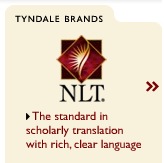Oct 2008
Safety Tips for Halloween
10/31/2008 18:19 Filed in: Miscellaneous

With Halloween upon us, it is worthwhile to remember a few helpful hints to keep this season healthy, happy and safe!
- When it appears that you have killed the monster, NEVER check to see if it’s really dead!
- Never read a book of demon summoning aloud, even as a joke.
- Do not search the basement, especially if the power has gone out.
- If your children speak to you in Latin or any other language which they should not know, get the h3ll out! This also applies to kids who speak with someone else’s voice.
- When you have the benefit of numbers, NEVER pair off and go alone.
- As a general rule, don’t solve puzzles that open portals to H3ll.
- Never stand in, on, or above a grave, tomb, or crypt. This rule applies to any other house of the dead as well.
- If appliances start operating by themselves, do not check for short circuits, just get the h3ll out!
- If you’re searching for something that caused a loud noise, only to find out that it’s just the cat, get the h3ll out!
- Do not take ANYTHING from the dead.
- If you find a town which looks deserted, there’s probably a good reason for it. Don’t stop and look around.
- Don’t fool with recombinant DNA technology unless you’re sure you know what you’re doing.
- If you’re running from a monster, expect to trip or fall down at least twice. Also note that, despite the fact that you are running and the monster is merely shambling along, it’s still moving fast enough to catch up with you.
- If your companion suddenly begins to exhibit uncharacteristic behavior, such as hissing, fascination for blood, glowing eyes, increased hairiness, and so on, kill them immediately. If will save you a lot of grief in the long run.
- Stay away from certain geographical locations, some of which are listed here: Amityville, Elm Street, Transylvania, or anywhere in Texas that chainsaws are sold.
- If your car runs out of gas at night on a lonely road, do not go to the nearby deserted-looking house to phone for help. If you think that it is strange you ran out of gas, because you thought you had almost a full tank, shoot yourself instead. You are going to die anyway, and most likely be eaten.
- If you find that your house is built upon a cemetery, now is the time to move in with the in-laws. This also applies to houses that had previous inhabitants that went mad or died in some horrible fashion.
- When investigating a noise downstairs in an old house, carry a flashlight, not a candle.
- Beware of strangers bearing tools. For example: chainsaws, staple guns, hedge trimmers, electric carving knives, combines, lawnmowers, butane torches, soldering irons or any devices made from deceased companions.
- And last but not least - Never go looking for witches in the Maryland countryside.
|
Philosophical Football II
10/24/2008 11:27 Filed in: Miscellaneous
Notice: some videos advertised after viewing the one below may contain profanity.
Pre-Game Coin Toss Makes Jacksonville Jaguars Realize Randomness Of Life
Thanks to Mark Strobel for sending me the link.
See also the previous installment.
Pre-Game Coin Toss Makes Jacksonville Jaguars Realize Randomness Of Life
Thanks to Mark Strobel for sending me the link.
See also the previous installment.
First Look: Hebrew & Greek Biblical Texts on the iPhone
10/24/2008 08:29 Filed in: Faith & Reason | Technology
For my initial review of Olive Tree’s Bible Reader for the iPhone, go here.
The screen shots below are from a beta released yesterday from Olive Tree (I have permission to post these images):
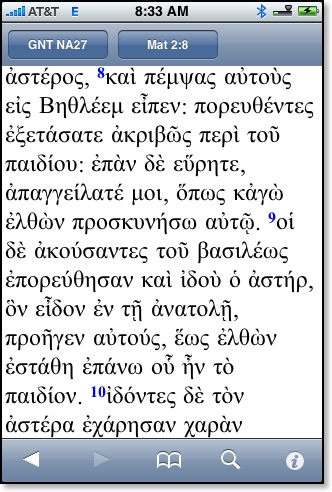

Frequent readers of This Lamp will know that I’ve lamented the loss of original language biblical texts “in my pocket” ever since switching from my Palm Treo to the iPhone last year. After a long wait, Olive Tree comes through with the promise a full replacement, and I have to admit that the texts look much better here than they ever did on my former device.
As you would expect, these texts are fully downloaded to the iPhone and do not require an internet connection for repeated access.
While I’ve got your attention, let me show you a couple of other things Olive Tree is working on for their Bible Reader.
Since my initial review, Olive Tree has incorporated links to textual notes and cross references in their modules.
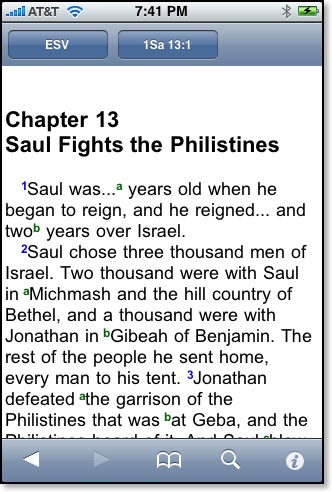
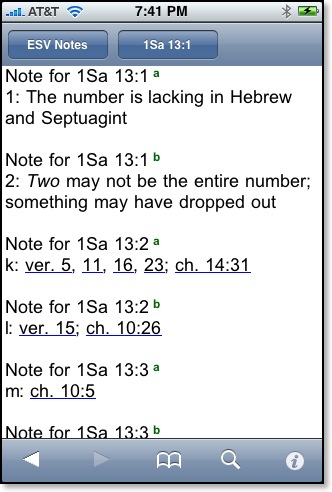
For instance, as demonstrated in the above modules, clicking/touching the superscript letters in the ESV leads to a appropriate section in the ESV notes. This is still not split screen, which I would prefer, but it’s a good start.
Traditionally, Olive Tree has allowed users who purchased texts for one platform to download these on any other platform as well. For instance, after purchasing modules for the Palm years ago, I was also able to download the same texts to a Windows Mobile device while I was testing one out a while back. However, this generous level of cross platform mobility has not been possible so far with the iPhone because Apple tightly controls iPhone apps and requires them to be distributed via the iTunes Store only with the exception of beta releases as seen in some of the images here). And not only do previously purchased modules have to be re-purchased, they have to be purchased separately. Again, this is not a policy from Olive Tree, but rather from Apple.
Right now, for instance, if an iPhone user purchases the NIV Family Pack for Bible Reader and the ESV Study Bundle, two separate installations of the Bible Reader are loaded with each respective set of modules. Other text reader programs in the iTunes App Store have been allowed to include modular purchases, so Olive Tree is trying to work with Apple to make the same kind of access available to users of their Bible Reader.
These screen shots below from a beta release (features not yet approved by Apple) show a “store” from Olive Tree where users could purchase texts directly for download over the internet to their iPhones. Once texts have been purchased and downloaded, they show up on a “My Olive Tree Account” page.
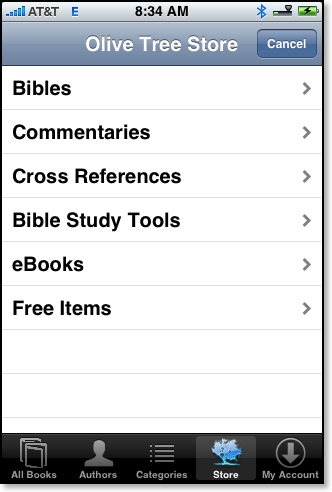

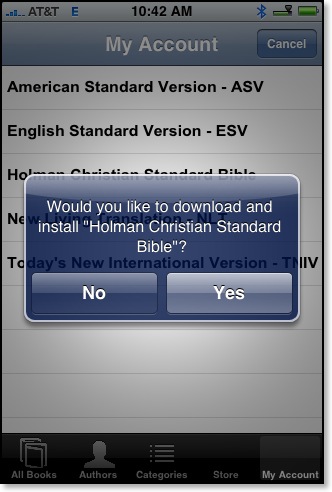


Let’s hope that Apple will approve Olive Tree’s solution because it’s a good and fair answer to the current modular dilemma.
See also:
• Olive Tree’s iPhone page
• To see Olive Tree’s current offerings in iTunes, search for “Olive Tree” in the iTunes Store Search window.
Then in the “Applications” box, select “See All.”
The screen shots below are from a beta released yesterday from Olive Tree (I have permission to post these images):


Frequent readers of This Lamp will know that I’ve lamented the loss of original language biblical texts “in my pocket” ever since switching from my Palm Treo to the iPhone last year. After a long wait, Olive Tree comes through with the promise a full replacement, and I have to admit that the texts look much better here than they ever did on my former device.
As you would expect, these texts are fully downloaded to the iPhone and do not require an internet connection for repeated access.
While I’ve got your attention, let me show you a couple of other things Olive Tree is working on for their Bible Reader.
Since my initial review, Olive Tree has incorporated links to textual notes and cross references in their modules.


For instance, as demonstrated in the above modules, clicking/touching the superscript letters in the ESV leads to a appropriate section in the ESV notes. This is still not split screen, which I would prefer, but it’s a good start.
Traditionally, Olive Tree has allowed users who purchased texts for one platform to download these on any other platform as well. For instance, after purchasing modules for the Palm years ago, I was also able to download the same texts to a Windows Mobile device while I was testing one out a while back. However, this generous level of cross platform mobility has not been possible so far with the iPhone because Apple tightly controls iPhone apps and requires them to be distributed via the iTunes Store only with the exception of beta releases as seen in some of the images here). And not only do previously purchased modules have to be re-purchased, they have to be purchased separately. Again, this is not a policy from Olive Tree, but rather from Apple.
Right now, for instance, if an iPhone user purchases the NIV Family Pack for Bible Reader and the ESV Study Bundle, two separate installations of the Bible Reader are loaded with each respective set of modules. Other text reader programs in the iTunes App Store have been allowed to include modular purchases, so Olive Tree is trying to work with Apple to make the same kind of access available to users of their Bible Reader.
These screen shots below from a beta release (features not yet approved by Apple) show a “store” from Olive Tree where users could purchase texts directly for download over the internet to their iPhones. Once texts have been purchased and downloaded, they show up on a “My Olive Tree Account” page.





Let’s hope that Apple will approve Olive Tree’s solution because it’s a good and fair answer to the current modular dilemma.
See also:
• Olive Tree’s iPhone page
• To see Olive Tree’s current offerings in iTunes, search for “Olive Tree” in the iTunes Store Search window.
Then in the “Applications” box, select “See All.”
Philosophical Fußball
10/17/2008 19:04 Filed in: Miscellaneous
I’ve got to remember to use this next time I teach Philosophy & Christian Thought at IWU.
Update: In the comments, Iyov pointed out that there is an entire Wikipedia article on this clip.
Repositioning the NLT as a "Scholarly Translation" [UPDATED]
10/08/2008 01:45 Filed in: Faith & Reason
Note: for the sake of clarification, I’ve offered a few footnotes since the original posting of this article a few hours ago.
Consider this a mild follow up to my post “The Rise of the New Living Translation,” but I’ll keep this one short and to the point.
Notice the graphic which I’ve swiped from the Tyndale website. Here the NLT is described as “The standard in scholarly translation with rich, clear language.” I have no real argument with this description. The NLT’s language is certainly richer and clearer than the NIV/TNIV, ESV, HCSB, and other contemporary translations. I’ve described the NLT as having phrasings closer to natural, conversational language than any other translation.
But is the NLT scholarly? I’d point to the translators involved and the continued fine tuning of the NLT through three revisions in 12 years to say, yes.
Granted this is the real question. We probably haven’t always thought of the NLT as a “scholarly” translation, and perhaps its status as such was more questionable in 1996, but it has continued to improve. As I pointed out in my “Rise” post, the creation of an NLT-dedicated commentary series such as the Cornerstone Biblical Commentary series, the tying of the translation to the original languages through the newly formulated “Tyndale Strong’s Numbering System,” and the publication of an NLT Study Bible at least on par with--if not slightly more academic than--the standard NIV Study Bible, all point to Tyndale’s repositioning of its flagship translation as a translation intended to be taken very seriously.
The link to the Tyndale Strong’s Numbering System in the paragraph above will take you to a post on the NLT blog asking if the NLT, as a dynamic translation, is suitable for word studies. The newest post on the NLT Study Bible Blog asks “The NLT: Good for Study?”
If you haven’t already guessed--YES, Tyndale is serious about this.
Look, I don’t know what it will take for the NLT to become a standard English translation in seminaries one day, but it’s not beyond imagination considering the NIV has held that spot for over two decades.1 But let’s put seminaries aside for the moment.
I currently teach in church and in the college classroom. My desire is for the people that I’m teaching to (1) understand the Bible, (2) take what they understand seriously, and (3) let the Bible transform their perspective on life and the world. However, I’ve often noticed when watching others teach the Bible that eyes glaze over when the Scriptures are being read. Reading from the Bible is often a cue to zone out. Why is this? Is it perhaps because we’re too used to what we’ve heard in Tyndale-family translations,2 and even from the NIV?
Granted, it never hurts to read the Bible with a little expression, and sadly many preachers and teachers don’t have a clue as to how to effectively read from the scriptures; but it may just be that it’s time for a new kind of translation to catch people’s attention. Maybe it’s time to use a translation that is fresh enough and bold enough to capture the spiritual imagination of people again.
As for the scholarly angle, there are a few things that Tyndale will have to do if they want to take things to the next level.
I do believe that Tyndale is smartly doing most things well in their promotion of the NLT and repositioning it as a translation both for serious study and one for scholarly pursuits, but there is still a lot of work to done creating a suitable scholarly context for the NLT before it is completely there. Nevertheless, as I originally pointed out in the “Rise” post, Tyndale is not going to be content to sit back and let the NLT continue to be seen as secondary translation to be read alongside supposedly more scholarly ones. Rather, the message being proclaimed is clear: the NLT can serve these purposes as well.3
1I’m referring primarily to conservative/evangelical schools, but the NIV has also gained acceptance beyond these circles where translations like the RSV and NRSV are considered standards.
2This can quickly become confusing. When I use the designation “Tyndale-family translations,” I’m referring to versions of the Bible that follow in the lineage established by William Tyndale including the KJV, RSV, NASB, NRSV, ESV and others. Obviously, the reader should not confuse this with the fact that the company, Tyndale House Publishers, publishes the NLT.
3As I’ve discussed before, my greatest challenge in using the NLT for teaching would come when discussing poetic passages. Although the second edition of the NLT is an improvement here, I still struggle with wanting to hold on to the beauty of some Hebrew metaphors that often become flattened out a bit in the NLT. However, that is not to say that I couldn’t use an approach such as that in Tom Gledhill’s helpful commentary on the Song of Solomon (The Message of Song of Songs [Bible Speaks Today], IVP) in which he uses both a free translation as well as a literal translation to get the meaning of the Hebrew text across.
Consider this a mild follow up to my post “The Rise of the New Living Translation,” but I’ll keep this one short and to the point.
Notice the graphic which I’ve swiped from the Tyndale website. Here the NLT is described as “The standard in scholarly translation with rich, clear language.” I have no real argument with this description. The NLT’s language is certainly richer and clearer than the NIV/TNIV, ESV, HCSB, and other contemporary translations. I’ve described the NLT as having phrasings closer to natural, conversational language than any other translation.
But is the NLT scholarly? I’d point to the translators involved and the continued fine tuning of the NLT through three revisions in 12 years to say, yes.
Granted this is the real question. We probably haven’t always thought of the NLT as a “scholarly” translation, and perhaps its status as such was more questionable in 1996, but it has continued to improve. As I pointed out in my “Rise” post, the creation of an NLT-dedicated commentary series such as the Cornerstone Biblical Commentary series, the tying of the translation to the original languages through the newly formulated “Tyndale Strong’s Numbering System,” and the publication of an NLT Study Bible at least on par with--if not slightly more academic than--the standard NIV Study Bible, all point to Tyndale’s repositioning of its flagship translation as a translation intended to be taken very seriously.
The link to the Tyndale Strong’s Numbering System in the paragraph above will take you to a post on the NLT blog asking if the NLT, as a dynamic translation, is suitable for word studies. The newest post on the NLT Study Bible Blog asks “The NLT: Good for Study?”
If you haven’t already guessed--YES, Tyndale is serious about this.
Look, I don’t know what it will take for the NLT to become a standard English translation in seminaries one day, but it’s not beyond imagination considering the NIV has held that spot for over two decades.1 But let’s put seminaries aside for the moment.
I currently teach in church and in the college classroom. My desire is for the people that I’m teaching to (1) understand the Bible, (2) take what they understand seriously, and (3) let the Bible transform their perspective on life and the world. However, I’ve often noticed when watching others teach the Bible that eyes glaze over when the Scriptures are being read. Reading from the Bible is often a cue to zone out. Why is this? Is it perhaps because we’re too used to what we’ve heard in Tyndale-family translations,2 and even from the NIV?
Granted, it never hurts to read the Bible with a little expression, and sadly many preachers and teachers don’t have a clue as to how to effectively read from the scriptures; but it may just be that it’s time for a new kind of translation to catch people’s attention. Maybe it’s time to use a translation that is fresh enough and bold enough to capture the spiritual imagination of people again.
As for the scholarly angle, there are a few things that Tyndale will have to do if they want to take things to the next level.
- Beef up Tyndale’s academic catalog. This is where Zondervan, primary US distributor of the NIV, has excelled. Tyndale has a few academic offerings, but there’s much room for improvement.
- Continue to connect the NLT to the original languages. I would suggest that Tyndale should immediately launch a project to publish a NLT/Greek diglot. Include notes that offer explanations behind particular NLT renderings from the Greek. Transliterate nothing. This should be a volume strictly for those who have a background in original languages.
- Publish a series of articles (maybe an ongoing series of books?) by the translators of the NLT regarding translational challenges and decisions behind the translation.
- Publish a series of preaching resources that use the NLT as a basis.
- Offer some serious gatekeeper editions: traditional format preaching editions, wide margin editions for study and teaching.
- Renew attention to the NLT apocrypha/deuterocanonicals. Publish an edition of the NLT with these books that is not labeled a “Catholic edition.”
- Make good use of testimonials from both academics and popular pastors.
- Hold off on any further revisions for at least a decade. Three editions in 12 years is unprecedented. The updates to the NLT have been warranted, but readers need to know that the text has been established/set--at least for a while.
I do believe that Tyndale is smartly doing most things well in their promotion of the NLT and repositioning it as a translation both for serious study and one for scholarly pursuits, but there is still a lot of work to done creating a suitable scholarly context for the NLT before it is completely there. Nevertheless, as I originally pointed out in the “Rise” post, Tyndale is not going to be content to sit back and let the NLT continue to be seen as secondary translation to be read alongside supposedly more scholarly ones. Rather, the message being proclaimed is clear: the NLT can serve these purposes as well.3
1I’m referring primarily to conservative/evangelical schools, but the NIV has also gained acceptance beyond these circles where translations like the RSV and NRSV are considered standards.
2This can quickly become confusing. When I use the designation “Tyndale-family translations,” I’m referring to versions of the Bible that follow in the lineage established by William Tyndale including the KJV, RSV, NASB, NRSV, ESV and others. Obviously, the reader should not confuse this with the fact that the company, Tyndale House Publishers, publishes the NLT.
3As I’ve discussed before, my greatest challenge in using the NLT for teaching would come when discussing poetic passages. Although the second edition of the NLT is an improvement here, I still struggle with wanting to hold on to the beauty of some Hebrew metaphors that often become flattened out a bit in the NLT. However, that is not to say that I couldn’t use an approach such as that in Tom Gledhill’s helpful commentary on the Song of Solomon (The Message of Song of Songs [Bible Speaks Today], IVP) in which he uses both a free translation as well as a literal translation to get the meaning of the Hebrew text across.
When Pumpkins Drink Too Much
10/04/2008 16:48 Filed in: Miscellaneous
Ten Years on a Mac (1998 to Present)
10/04/2008 14:50 Filed in: Technology

In the summer of July, 1998, I was Associate Pastor of Church Growth and Development at Springdale Church. We had just begun experimenting with a projector and screen during our worship services, something that is very common in churches today. Perhaps because I had a copy of PowerPoint or perhaps because I had a Toshiba laptop that I could take into the auditorium, I had been assigned to work with the worship staff and prepare the slides for each Sunday’s service.
In preparing these slides, rather than working on my laptop’s 10.4” screen, I thought it would be easier to use the brand new Compaq PC in my office and then transfer the PowerPoint file to my laptop. I had only one problem: every week as I prepared the slides, I had to suffer through multiple crashes of PowerPoint ’97 in Windows ’98.
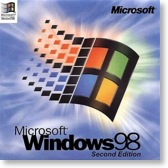
I was also a bit of a Microsoft snob. I knew there were other platforms out there as well as other presentation software packages, but I was certain that Office would surely run better on Windows than anything else because both were Microsoft products. I would learn this wasn’t necessarily so.
I’ve always had a high expectation with computers, regardless of what platform I’ve used. Is it unreasonable to expect them to operate as their promoters promise? With PowerPoint constantly crashing, I felt like I was wasting valuable time. It’s at this point, I decided there had to be a viable alternative. I began looking at other programs as well as other platforms.
Okay, I have to admit that I had tremendous prejudice against Apple and the Macintosh platform--all the regular stuff you hear from hardcore Windows folks. Part of my bias went all the way back to a computer class I took in 11th grade in high school. We learned to program BASIC on both the Apple IIe and the TRS-80 Model IV. The BASIC programming language on both machines was written by Microsoft, but for whatever reason programming on the Apple computers often required extra lines of instruction not needed on the TRS-80s. My bias against Apple came early and was based on experience.
In 1998, Apple was just starting to come out of its darkest days. Steve Jobs had returned after more than a decade long exile from the company he’d co-founded. An exciting new self-contained computer called the iMac had been announced that featured a see-through case and a strange technology known as “USB.” There seemed to be a buzz about Apple all of a sudden, and my interest was piqued.
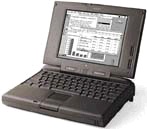
In spite of my bias against all things Apple, I had to admit that my experience with that particular PowerBook at been positive--or at the very least, I had no major complaints. I couldn’t remember applications crashing on me. But at the same time, I never used the PowerBook 5300cs as intensely as I used my Windows PCs.
So, I started seriously investigating the Mac platform. I talked to Mac users on online forums. They promised me that Macs never crash. That was certainly not true, but ironically, after making the switch I was pleased to discover that Microsoft PowerPoint for the Mac was indeed more stable than the Windows version in Windows 98.
I had three concerns in switching. At the time I was using a number of Adobe apps: PageMaker, Photoshop, and Illustrator. This was before the days of the Creative Suite and they had to be bought separately. I was very pleased to see that all three were available for the Mac. In fact, back in 1998, the Mac versions turned out to actually be a bit better than the Windows version--especially Illustrator. I had already seen that I could get Microsoft Office (Word, PowerPoint, and Excel) on the Mac. There wasn’t a Mac version of Microsoft Access, but I only maintained a couple of databases, which I realized I could manually convert to FileMaker Pro which I later did. For the sake of transition, I could even run Windows 98 on a Mac through VirtualPC from Connectix (later bought by Microsoft). It was pokey, but it worked.
My greatest concern was Bible software. At the time, I was using BibleWorks for Windows, and there wasn’t a Mac version. So in my research I came across Accordance Bible Software, which at the time was partnered with the well-respected Gramcord Institute. The more I read about Accordance, the more impressed I became. As powerful as BibleWorks was, Accordance promised to take things to the next level. In the end, of course, I made the switch, but I always credit Accordance as being the final solution to convince me to go over to the Mac.
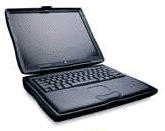
The Wallstreet II was the last PowerBook to include the “rainbow” colored Apple at the bottom of the screen. It still relied on serial and ADB connectors even though Apple was transitioning to USB in its desktop machines around this time. However, with the PowerBook’s card slots, I was able to add USB and even Firewire capabilities to it eventually. In many ways, that PowerBook offered the best of old and new technology in one machine.
When I received my PowerBook, it was running Mac OS 8.1 but there was already stirrings in the Mac community about the replacement operating system eventually named OS X. In the end it was OS X that made me give up my Wallstreet II PowerBook in 2001. I was an early adopter of OS X, which the Wallstreet PowerBook could run just fine but with one exception. Initially the first versions of OS X didn’t offer DVD playback. This wasn’t a huge deal because as Apple transitioned to OS X, the user was able to boot into either OS 9 or OS X. However, once DVD playback was finally added to OS X (around version 10.1.5 if I remember correctly), the Wallstreet was left out in the cold. For whatever reason, DVD playback wasn’t included on that particular model. Regardless, I had three very good years with that first Mac.
I still remember after my initial transition to the Mac platform how lost I felt at times. I had been extremely comfortable with both DOS and Windows. I remember sitting in front of my new Mac, sometimes struggling to figure out how to do something I already knew how to do in Windows, wondering if there would ever come a day that I would know the Mac as well or better than I knew Windows.
That day came soon enough, but I’ve never completely taken both feet out of the Windows world. After I left my church position, I worked briefly part time for a computer support company in which 90% of our work was on Windows machines. As I daily fixed problems with Windows machines which would not have been problems on Macs, my decision to switch was confirmed over and over. Later, I would become a chaplain and Bible teacher at a private school where one of my responsibilities was to oversee a computer network consisting of three Windows servers and about 140 Windows client machines. I convinced our headmaster to allow me to buy an eMac which I was able to use to monitor and maintain all three servers and the entire Windows network thanks to Windows Remote Desktop. In fact, when French hackers breached our firewall and set up UNIX directories on our servers, unseen from the Windows Explorer, it was my UNIX-based OS X Mac that was able to go in and delete the hackers’ files.
Even today, now with a couple of Intel based Macs, I occasionally find a need to fire up Windows using Parallels. It’s no longer quite so pokey because emulation is no longer needed since Macs and PC’s share the same Intel processors these days. I’ll admit up front that with the advent of Windows 2000, the Windows platform itself became more stable and less prone to crashes like I experienced in 1998. But on a Mac, I don’t have to worry about viruses, spyware and the like that is a constant threat on any Windows machine.
Could I switch back to Windows? Well, I could if I wanted to with little transition or slowdown. The fact is, however, I have no desire. The old joke someone told me back when I was researching the Mac platform in 1998 was that “Once you go Mac, you never go back.” It’s true. I have no need or desire to go back. And I assume the next ten years will be even better and more interesting than the first.
CT Posts Review of Bill Maher's Religulous
10/03/2008 14:06 Filed in: Movies and Television
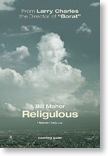
Honestly, it's not the hardest thing in the world to make a religion look silly when you only focus on the kitschiest, most grimace-inducing practitioners of it. Sure, we have to own up to these unfortunate (but fortunately fringe) elements within our ranks, but Maher shores up little credibility for his cause by refusing to talk with any opponent with an ounce of nuance of theological rigor.
Here’s an idea: let’s spend the next year praying for Bill Mahar’s conversion to Christianity. Let’s pray that God sends him on a dramatic and undeniable “Damascus Road” type of experience. Sometimes this is what it takes for those who are furthest from God. Knowing Mahar, you might think this is an impossible thing to pray for, but remember Jesus’ words in relation to those of whom we doubt can find salvation: “The things that are impossible with people are possible with God” (Luke 18:27, NASB).
TNIV Gate Keeper Profiles, Part 3
10/03/2008 13:25 Filed in: Faith & Reason
This post is the 3rd part of a series in which the winners of Zondervan’s Renaissance Fine Leather TNIV Reference Bible tell their own story of why they use the TNIV.
Jeremy O'Clair
Church of Christ, College-level Bible Teacher
Tallahassee, Florida
I've been using the TNIV for about three years now. At my (then) seminary, our dean passed out TNIV Bibles to all the seminary students interested in having a copy -- a simple black hardback. Since it was a relatively new release I decided to give it a try and came to like the overall clarity of the translation. I started out reading through the Bible with the TNIV audio online (Genesis, Exodus, etc.), and really liked how clear and understable the translation was for me. Of course, I would check it against the original Hebrew or Greek if there was a passage I wanted to investigate closer through a word study or exegesis.
In summer 2007 I taught a class on Galatians using the TNIV while interning at my parents' church; then after moving to Tallahassee last fall I also taught Galatians, with the TNIV, at the church I attend, teaching the college class. Since then we've worked through 2 Peter and some history of the Bible. I'm now co-teaching through the book of Romans while I use the TNIV and the other teacher uses his NRSV -- so it should be interesting how the class turns out when comparing the two translations!
The gender inclusive language is another reason I use the TNIV. I like the rendering of the generic masculine nouns (such as anthropos, adelphoi, etc.), but how the TNIV, naturally, retains gender specific words such as ἀνήρ/aner and γυνή/gune. I've been trying to enlighten people on this subject, with the TNIV in one hand, and Greek text in the other, looking at this translation preference in many passages (there weren't mere brothers in the congregations but there were brothers AND sisters!).
Basically, the readability of the TNIV really works for me. For the most part the readings have been quite smooth. But if there is a reading that might seem too glossed over, I'll check the original languages and inform my audience of the translator's task when it comes to translating Scripture.
Debbie Fulthorp
Pastor, Grand Canyon Assembly of God
Grand Canyon, Arizona
My husband and I co-pastor the Assembly of God church inside the Grand Canyon National Park (South Rim). We believe that our church is in a strategic location to reach nations for Christ. We feel that we are not only pastoring a church, but the community God called us to. Because of that reason, we prefer to use the TNIV Bible. We minister on a regular basis to people who are unchurched, and may have never heard the story of Jesus, let alone read the Bible. We have found that using the TNIV circumvents questions about various passages and also uses language non-English speakers can understand. For example, through divinely appointed relationships we were able to give one of the Royalty in Thailand a Bible. Another girl who was Muslim, recently dedicated her life to Jesus. The TNIV is perfect for those who have not been in the church because they can understand that ALL PEOPLE can come the the cross regardless of gender, nationality, age, or economic status.
On a more personal note, I love the TNIV because I am a pastor. I experienced the TNIV my first year in seminary, before I fully understood that God could call a woman to be a pastor. Studying the Greek texts and comparing the TNIV side by side at various texts, brought me one step closer in my journey towards following the will of God for my life. I had no idea God could use me as a pastor, but through studying the TNIV and comparing Greek texts (at the time only New Testament was available) gave me the theological underpinnings for the ministry God placed my husband and I in today.
I love the TNIV because it has given us so many doors for ministry, sharing the gospel to men and women unbiasedly where they can understand it.
My husband and I as well as our church are gatekeepers as we minister together in one of the most transitional places of ministry. We might be a small missions church, but we see the Gates of the Grand Canyon National Park as our place of ministry where every nation, tribe and tongue should have a chance to know God through hearing His Word and experiencing Him through personal relationship!
Feel free to interact with Jeremy & Debbie in the comments.
Other posts:
Part 1
Part 2
Jeremy O'Clair
Church of Christ, College-level Bible Teacher
Tallahassee, Florida
I've been using the TNIV for about three years now. At my (then) seminary, our dean passed out TNIV Bibles to all the seminary students interested in having a copy -- a simple black hardback. Since it was a relatively new release I decided to give it a try and came to like the overall clarity of the translation. I started out reading through the Bible with the TNIV audio online (Genesis, Exodus, etc.), and really liked how clear and understable the translation was for me. Of course, I would check it against the original Hebrew or Greek if there was a passage I wanted to investigate closer through a word study or exegesis.
In summer 2007 I taught a class on Galatians using the TNIV while interning at my parents' church; then after moving to Tallahassee last fall I also taught Galatians, with the TNIV, at the church I attend, teaching the college class. Since then we've worked through 2 Peter and some history of the Bible. I'm now co-teaching through the book of Romans while I use the TNIV and the other teacher uses his NRSV -- so it should be interesting how the class turns out when comparing the two translations!
The gender inclusive language is another reason I use the TNIV. I like the rendering of the generic masculine nouns (such as anthropos, adelphoi, etc.), but how the TNIV, naturally, retains gender specific words such as ἀνήρ/aner and γυνή/gune. I've been trying to enlighten people on this subject, with the TNIV in one hand, and Greek text in the other, looking at this translation preference in many passages (there weren't mere brothers in the congregations but there were brothers AND sisters!).
Basically, the readability of the TNIV really works for me. For the most part the readings have been quite smooth. But if there is a reading that might seem too glossed over, I'll check the original languages and inform my audience of the translator's task when it comes to translating Scripture.
Debbie Fulthorp
Pastor, Grand Canyon Assembly of God
Grand Canyon, Arizona
My husband and I co-pastor the Assembly of God church inside the Grand Canyon National Park (South Rim). We believe that our church is in a strategic location to reach nations for Christ. We feel that we are not only pastoring a church, but the community God called us to. Because of that reason, we prefer to use the TNIV Bible. We minister on a regular basis to people who are unchurched, and may have never heard the story of Jesus, let alone read the Bible. We have found that using the TNIV circumvents questions about various passages and also uses language non-English speakers can understand. For example, through divinely appointed relationships we were able to give one of the Royalty in Thailand a Bible. Another girl who was Muslim, recently dedicated her life to Jesus. The TNIV is perfect for those who have not been in the church because they can understand that ALL PEOPLE can come the the cross regardless of gender, nationality, age, or economic status.
On a more personal note, I love the TNIV because I am a pastor. I experienced the TNIV my first year in seminary, before I fully understood that God could call a woman to be a pastor. Studying the Greek texts and comparing the TNIV side by side at various texts, brought me one step closer in my journey towards following the will of God for my life. I had no idea God could use me as a pastor, but through studying the TNIV and comparing Greek texts (at the time only New Testament was available) gave me the theological underpinnings for the ministry God placed my husband and I in today.
I love the TNIV because it has given us so many doors for ministry, sharing the gospel to men and women unbiasedly where they can understand it.
My husband and I as well as our church are gatekeepers as we minister together in one of the most transitional places of ministry. We might be a small missions church, but we see the Gates of the Grand Canyon National Park as our place of ministry where every nation, tribe and tongue should have a chance to know God through hearing His Word and experiencing Him through personal relationship!
Feel free to interact with Jeremy & Debbie in the comments.
Other posts:
Part 1
Part 2










